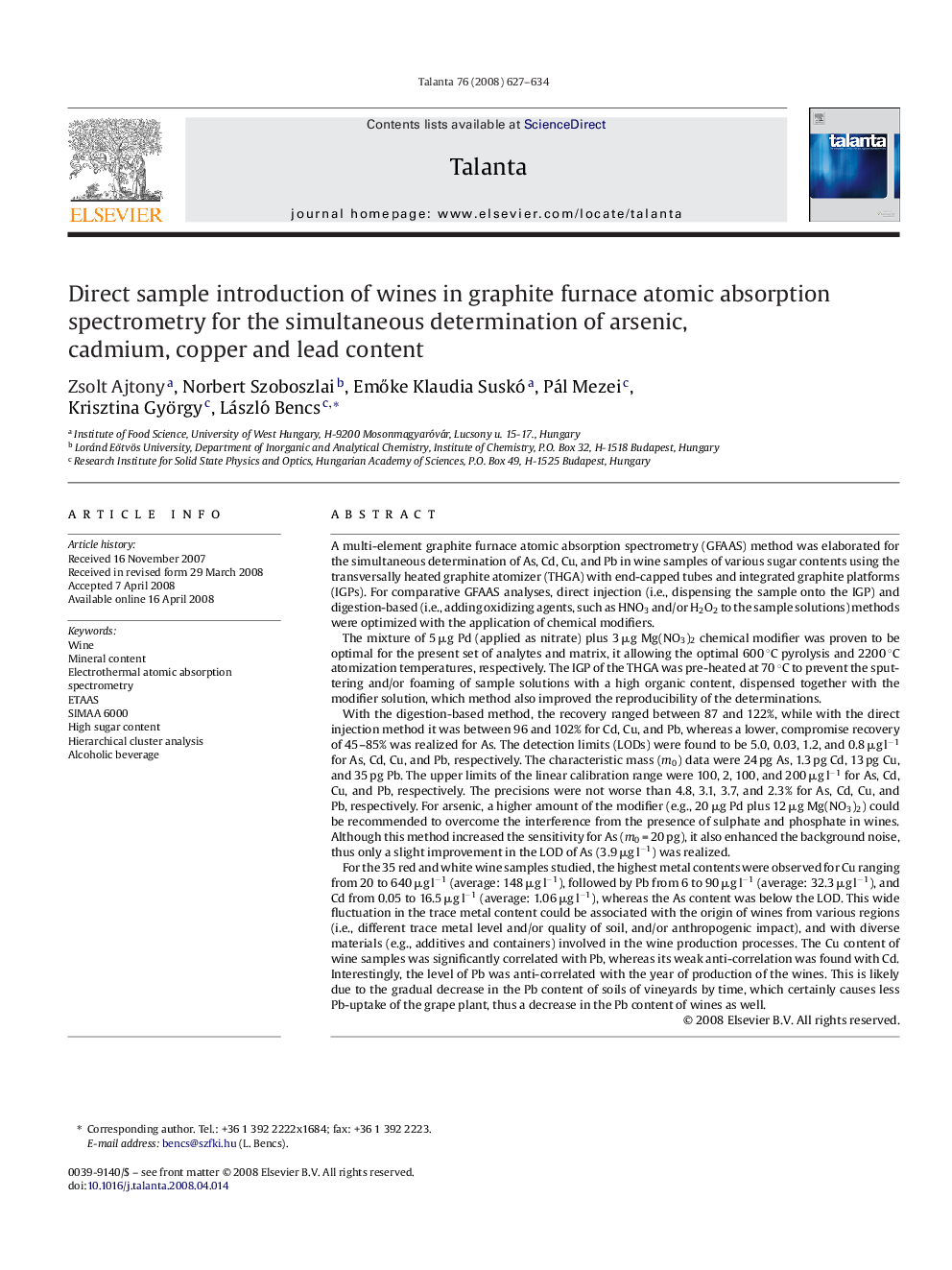| کد مقاله | کد نشریه | سال انتشار | مقاله انگلیسی | نسخه تمام متن |
|---|---|---|---|---|
| 1243534 | 969664 | 2008 | 8 صفحه PDF | دانلود رایگان |

A multi-element graphite furnace atomic absorption spectrometry (GFAAS) method was elaborated for the simultaneous determination of As, Cd, Cu, and Pb in wine samples of various sugar contents using the transversally heated graphite atomizer (THGA) with end-capped tubes and integrated graphite platforms (IGPs). For comparative GFAAS analyses, direct injection (i.e., dispensing the sample onto the IGP) and digestion-based (i.e., adding oxidizing agents, such as HNO3 and/or H2O2 to the sample solutions) methods were optimized with the application of chemical modifiers.The mixture of 5 μg Pd (applied as nitrate) plus 3 μg Mg(NO3)2 chemical modifier was proven to be optimal for the present set of analytes and matrix, it allowing the optimal 600 °C pyrolysis and 2200 °C atomization temperatures, respectively. The IGP of the THGA was pre-heated at 70 °C to prevent the sputtering and/or foaming of sample solutions with a high organic content, dispensed together with the modifier solution, which method also improved the reproducibility of the determinations.With the digestion-based method, the recovery ranged between 87 and 122%, while with the direct injection method it was between 96 and 102% for Cd, Cu, and Pb, whereas a lower, compromise recovery of 45–85% was realized for As. The detection limits (LODs) were found to be 5.0, 0.03, 1.2, and 0.8 μg l−1 for As, Cd, Cu, and Pb, respectively. The characteristic mass (m0) data were 24 pg As, 1.3 pg Cd, 13 pg Cu, and 35 pg Pb. The upper limits of the linear calibration range were 100, 2, 100, and 200 μg l−1 for As, Cd, Cu, and Pb, respectively. The precisions were not worse than 4.8, 3.1, 3.7, and 2.3% for As, Cd, Cu, and Pb, respectively. For arsenic, a higher amount of the modifier (e.g., 20 μg Pd plus 12 μg Mg(NO3)2) could be recommended to overcome the interference from the presence of sulphate and phosphate in wines. Although this method increased the sensitivity for As (m0 = 20 pg), it also enhanced the background noise, thus only a slight improvement in the LOD of As (3.9 μg l−1) was realized.For the 35 red and white wine samples studied, the highest metal contents were observed for Cu ranging from 20 to 640 μg l−1 (average: 148 μg l−1), followed by Pb from 6 to 90 μg l−1 (average: 32.3 μg l−1), and Cd from 0.05 to 16.5 μg l−1 (average: 1.06 μg l−1), whereas the As content was below the LOD. This wide fluctuation in the trace metal content could be associated with the origin of wines from various regions (i.e., different trace metal level and/or quality of soil, and/or anthropogenic impact), and with diverse materials (e.g., additives and containers) involved in the wine production processes. The Cu content of wine samples was significantly correlated with Pb, whereas its weak anti-correlation was found with Cd. Interestingly, the level of Pb was anti-correlated with the year of production of the wines. This is likely due to the gradual decrease in the Pb content of soils of vineyards by time, which certainly causes less Pb-uptake of the grape plant, thus a decrease in the Pb content of wines as well.
Journal: Talanta - Volume 76, Issue 3, 30 July 2008, Pages 627–634